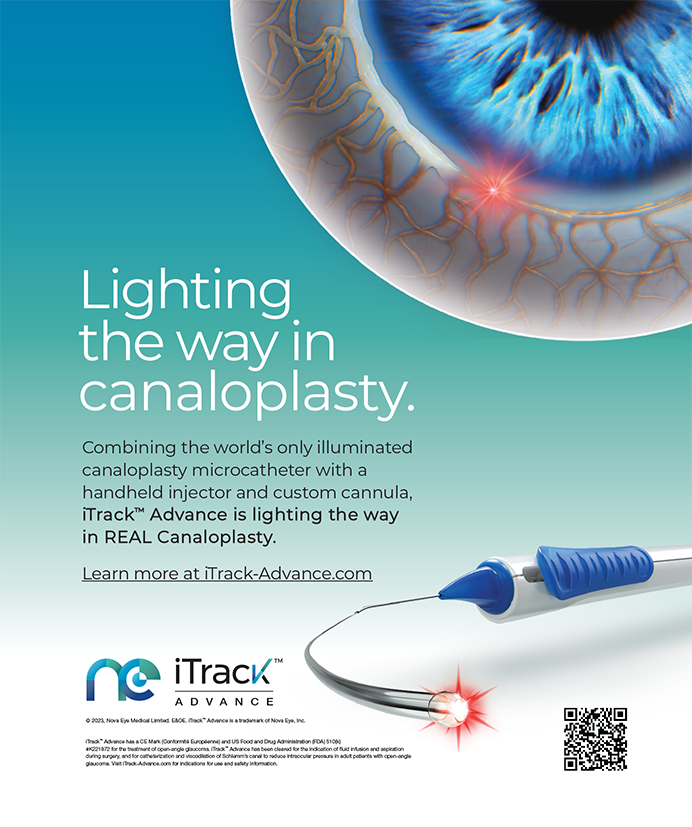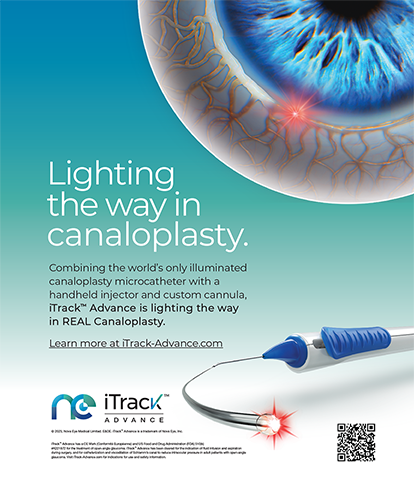The popularity of LASIK over PRK demonstrates that patients care about more than their visual outcome. In our experience, today’s prospective candidates for refractive surgery are less likely to ask about their final visual acuity than about how much “downtime” they can expect after surgery. In a fast-paced world, it is the “opportunity cost” of patients’ time that often matters most; they are concerned about the amount of time away from work or school, if they can drive after the procedure, and when they can return to performing daily activities.
We recently demonstrated that the speed of visual recovery after thin-flap LASIK is rapid, with 100% of patients seeing 20/20 within 4 hours postoperatively and 100% seeing 20/16 or better on the first postoperative day.1 Rapid visual recovery is a result of better laser technology. Advances in excimer lasers have brought to the OR more sophisticated ablation profiles reduced ablation depths, optimized or customized ablation shapes and blend zones, iris registration, dynamic eye trackers, and intraoperative correction for both dynamic and static cyclotorsion. Faster excimer lasers have reduced the duration that the flap is reflected and the stromal bed is exposed.2 In the realm of femtosecond lasers, faster repetition rates have allowed surgeons to reliably complete flaps in less than 10 seconds with low, optimized spot/line separation settings, which provide ophthalmologists with fewer tissue bridges to break when lifting the flap and less resultant corneal edema.
Although advances in laser technology have certainly improved the speed of visual recovery, refractive surgeons have yet to reach the ideal of “lunchtime LASIK,” meaning patients cannot yet drive back to work after their procedure. Taking the speed of visual recovery to the next level will likely require new technology. One promising device is the Nexis Ocular Shield (Nexis Vision, Inc.).
POST-LASIK SHIELD
The Nexis Ocular Shield (Figure 1) was initially designed to supplement corneal healing and improve visual rehabilitation after PRK. To enhance epithelial healing, its proprietary material has very high oxygen permeability, especially overlying the area of the limbus. Because it is impermeable to water, the ocular shield accelerates the resolution of edema. Its unique design provides a secure fit to offer a stable and protective environment during healing. Additionally, the ocular shield provides a smoother optical center than does a bandage contact lens. These factors allow the ocular shield to consistently deliver faster healing and accelerate visual recovery.
Data from studies conducted by our practice and by Stephen Slade, MD, compared visual recovery with the Nexis Ocular Shield after PRK against historical controls for standard PRK. The difference was dramatic. On the first postoperative day, 100% of eyes with the ocular shield versus less than half (42%) of standard PRK eyes had a visual acuity of 20/40 or better. In fact, with the ocular shield, visual recovery after PRK rivaled rates for standard LASIK: 64% of ocular shield eyes saw 20/20 or better on the first postoperative day. These results encouraged us to investigate if the shield could speed up visual recovery after LASIK as it does after PRK.
MEASURING VISUAL RECOVERY
We conducted a multicenter study examining visual recovery with the Nexis Ocular Shield after thin-flap LASIK. Postoperative examinations were performed immediately at the conclusion of surgery and 30 minutes; 1, 2, and 4 hours; and 1 day postoperatively. The shields were removed 4 hours after surgery. At each of these time points, we assessed binocular and monocular uncorrected distance visual acuity, and patients were required to complete a subjective questionnaire that addressed visual function tasks. We were particularly interested in their comfort with driving and using a cell phone. Data were compared to a normative database we obtained from our previous study of early postoperative visual recovery after thin-flap LASIK without the shield.1
VISUAL ACUITY
We found that, compared to our historical data, the monocular uncorrected high-contrast visual acuity improved more rapidly in patients who were treated with the ocular shield (Figure 2). The average visual acuity in this group reached 20/20 within 1 hour after surgery. The average visual acuity was 20/25+2 immediately after surgery, 20/20-2 30 minutes after surgery, and 20/20 1 hour postoperatively. In contrast, patients who underwent LASIK and were not treated with the ocular shield achieved 20/40+1 visual acuity immediately after surgery, and it took 4 hours on average for their visual acuity to return to 20/20.
In terms of binocular high-contrast visual acuity, three times as many ocular shield patients were able to see 20/20 immediately and 30 minutes after surgery (Figure 3). Seventy-four percent of ocular shield patients achieved a visual acuity of 20/20 or better within 30 minutes of surgery (compared to 23% of standard LASIK patients), and 90% of ocular shield patients achieved a visual acuity of 20/20 or better within 2 hours of surgery. It took 4 hours for the standard LASIK patients to reach the ocular shield patients’ visual acuity.
CONTRAST SENSITIVITY AND FUNCTIONAL VISION
LASIK patients experience a transient but significant reduction in contrast sensitivity after surgery due to procedure-induced corneal edema, which can lead to “frosty” vision. According to our data, eyes with the ocular shield demonstrated accelerated resolution of edema, and contrast sensitivity returned to baseline faster than among the conventional LASIK patients, most notably at higher spatial frequencies (12 and 18 cycles per degree).
With the ocular shield, twice as many patients (80%) felt comfortable driving within 2 hours of surgery (Figure 4). By 4 hours after surgery, the standard LASIK group caught up to the ocular shield group for this parameter. It was not until the 1-day postoperative examination that all patients felt comfortable driving in either group. Most patients were able to text soon after surgery, although in the first postoperative hour, the ocular shield patients demonstrated a slight advantage, with over 80% reporting that they were comfortable sending a text message.
COMFORT
Patients’ comfort with the ocular shield compared favorably to traditional LASIK surgery, with patients in the former group noting mild to moderate postoperative discomfort in most areas surveyed, including burning and light sensitivity. By the first-day postoperative visit, discomfort levels were no more than mild in any category.
FUTURE STUDY
We plan to investigate how long the ocular shield should be left on after surgery to achieve optimal results. Is it 2, 4, or 24 hours? We will also explore whether the ocular shield obviates the need for goggles or a plastic protective shield over the eyes at night in the early postoperative period.
CONCLUSION
The speed of visual recovery after LASIK has improved significantly in the last decade. Nearly all patients achieve 20/40 visual acuity within 4 hours and 20/20 24 hours postoperatively. The visual recovery of our LASIK patients with the Nexis Ocular Shield was faster than that of those without it. This device holds promise for refractive surgeons who wish to take patients’ visual recovery to the next level.
Section Editor George O. Waring IV, MD, is the director of refractive surgery and an assistant professor of ophthalmology at the Storm Eye Institute, Medical University of South Carolina. He is also the medical director of the Magill Vision Center in Mt. Pleasant, South Carolina. Dr. Waring may be reached at waringg@musc.edu.
Jason P. Brinton, MD, is a partner at Durrie Vision in Overland Park, Kansas, and an assistant professor of clinical ophthalmology at the University of Kansas. He acknowledged no financial interest in the products or companies mentioned herein. Dr. Brinton may be reached at jpbrinton@gmail.com.
Daniel S. Durrie, MD, is the president of Durrie Vision in Overland Park, Kansas, and a professor of clinical ophthalmology and director of refractive surgery at the University of Kansas. He is a consultant to Nexis Vision, Inc. Dr. Durrie may be reached at (913) 491-3330; ddurrie@durrievision.com.
- Durrie DS, Brinton JP, Avila MR, Stahl ED. Evaluating the speed of visual recovery following thin-flap LASIK with a femtosecond laser. J Refract Surg. 2012;28:620-624.
- Maldonado MJ, Nieto JC, Pinero DP. Advances in technologies for laser-assisted in situ keratomileusis (LASIK) surgery. Expert Rev Med Devices. 2008;5:209-229.


